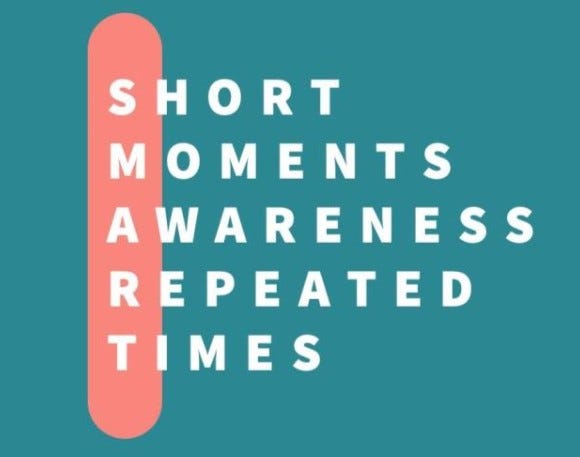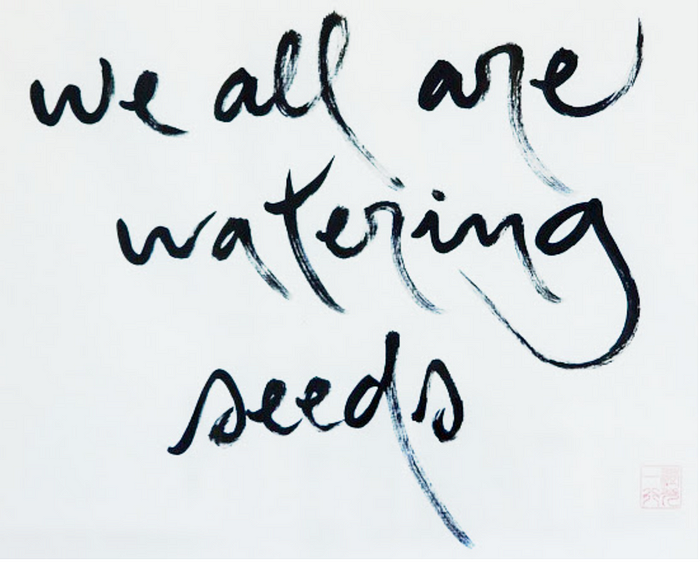Five Strategies to Care for Yourself So You Can Care for Others

In times of change and uncertainty, it’s essential to find ways to support ourselves and others. I’ve identified five key strategies that have become my anchor, helping to support my family, colleagues, and community. These strategies are deeply rooted in my life and practice, offering concrete steps to navigate challenging times.
1. RESOURCE YOURSELF FIRST. Ask yourself: What’s one essential thing I need to do daily to support my wellbeing? Then DO THAT one thing consistently and make sure it’s part of your daily routine. CALENDAR IT! Know there are several practices out there to cultivate awareness, communion and connection that could be nourishing at this time. Check out the Tree of Contemplative Practices developed by The Center for Contemplative Mind & Society. I also love to engage in SMART breaks throughout the day by using gathas, short verses that gently bring me into the present moment.

2. TOUCH, SAVOR & SOAK IN JOY. Negativity bias is a natural evolutionary part of who we are as humans. Anything we experience that’s negative will have a greater effect on our psychological state than anything that’s positive even if it’s of equal intensity. Rick Hanson says our brain is like velcro for the negative and Teflon for the positive so we have to DELIBERATELY practice touching, savoring and soaking in positive states. Any time you have a positive experience pause to touch, savor, and soak it in for at least 30 seconds or more. I invite you to focus in on joy in particular because it’s one of the most positive feeling states. The research of Gottman and Levenson has shown us that it takes five positive interactions to counter a single negative one. Try to practice the 5:1 rule as you consider your news consumption. It’s important to be aware and informed but we can reduce our servings of news to be in better balance with our positive experiences. I try to limit my news intake each day to 10 minutes or less.
3. PRACTICE THE REFRAME. “When you change the way you look at things, the things you look at change.” (Wayne Dyer) Reframing is a powerful strategy where we can create a different way of looking at a situation, person, or relationship by changing its meaning. The ways we practice the reframe vary depending on our context. The most frequent way I practice the reframe is shifting from saying, “I have to…” to “I get to…” For example, instead of “I have to do the laundry.” I now say, “I GET to do laundry,” I sed to live in a walk up apartment building where 30 of us shared one washer and dryer. I now have the luxury of having my own washer and dryer for our family. What a gft it is to have clean, fresh clothes. Instead of, “I have to wash the dishes,” I now say, “I GET to wash the dishes.” I’m grateful I have food to eat and a home to live in. I also have precious running water. Another powerful reframe I heard from a monk in my spiritual community, Brother Phap Hai, is shifting from saying, “What’s the meaning of life?” to “How can I bring meaning to this moment?” Making this shift lifts up the agency we have and this is so important! I’ve been practicing the reframe for many years but now it’s become even more vital to my health and wellbeing.
4. WATER HELPFUL SEEDS. We all have helpful and unhelpful seeds of emotion inside of us. Depending on which seeds we choose to water, some will grow more than others. Mindfulness helps us build awareness around which seeds we are watering. The practice of seed watering is a foundational part of Thich Nhat Hanh’s teachings and it reminds me of the Two Wolves story in which a Cherokee elder tells his grandson that there is a battle between two wolves inside us all. One wolf is hatred, greed, anger, and jealousy, and the other wolf is kindness, peace, love, and generosity. When the elder’s grandson asked, “Who wins?” his grandfather replied, “Whichever one you feed.” Our feeling states have vibrational frequencies and our subconscious is very well attuned to whether something has a helpful or unhelpful benefit for the body. Wisdom teachers often tell us that in every moment we have a choice to choose love or choose fear. A powerful practice of mine is to bring the question “What would LOVE do now?” to each moment.

5. MAKE SELF-COMPASSION CENTRAL. There’s so much unfolding in our world right now and it’s essential that we practice compassion towards ourselves. For me, self-compassion involves holding myself with tenderness and being warm and understanding toward myself when I suffer rather than ignoring my pain or criticizing myself. Doing this allows us to hold ourselves in love and connection. Acknowledging our suffering lifts up our common humanity. We all suffer at times and collectively what we are all experiencing now is very difficult across contexts. The two ways I most love to practice self-compassion are affectionate breathing and engaging in the practice, “How would you treat a friend?” This involves utilizing the following questions as you engage in a self-compassionate inquiry (Neff & Germer):
● Reflect on when a close friend feels really bad about themselves or is suffering in some way. How would you speak to your friend?
● Now reflect on a time when you feel bad about yourself or are suffering. Write down what you would usually say. Notice your tone as well.
● Did you see a difference? If so, reflect for yourself why you treated yourself differently than how you’d treat a friend.
● Write down how what you say would change if you responded to yourself in the same way you’d respond to a friend who’s suffering. Commit to treating yourself like a good friend!
NOW COMMIT TO HOLDING ONE OF THESE FIVE STRATEGIES FRONT & CENTER!
Make a plan for how to hold yourself in loving accountability or find an accountability partner. According to The American Society of Training and Development, you have a 65% greater chance of following through on a commitment if you share your intention with someone. Try making a specific “accountability appointment” with another person to increase your chances of following through by up to 95%!
Author Bio: Meena Srinivasan is a contemplative leader, celebrated speaker, accomplished author, and visionary edupreneur. She is an educator-activist at heart, consistently championing the fusion of Mindfulness, Emotional Intelligence, and Belonging. Meena was featured as one of 2022’s 10 Powerful Women of the Mindfulness Movement in Mindful Magazine and is the Executive Director of Transformative Educational Leadership (TEL)™ an organization that supports educational leaders in building more compassionate and just schools. A former public school administrator and National Board Certified Teacher, Meena is the creative force behind the SEL Every Day Online Courses, an instructor of graduate level Social and Emotional Learning (SEL) courses at UC Berkeley and the CEO of Karuna Consulting, LLC, an organization that takes its name from the Sanskrit word ‘Karuna,’ signifying compassion. Karuna Consulting is a certified Minority Business Enterprise (MBE) driven by a profound mission: to foster a more compassionate world through Meena’s keynotes, professional learning, coaching, and consulting services. She is the author of numerous publications including Teach, Breathe, Learn and SEL Every Day. The latter was honored as one of 2019’s Favorite Books for Educators by the Greater Good Science Center at UC Berkeley. Her TEDx talk on Tenderness is one of the most popular TEDx talks of 2024 (with over 2 million views). Meena has been practicing yoga and meditation for over 25 years, is an ordained Zen Buddhist and serves on the Board of the Thich Nhat Hanh Foundation. Learn more at meenasrinivasan.com.
